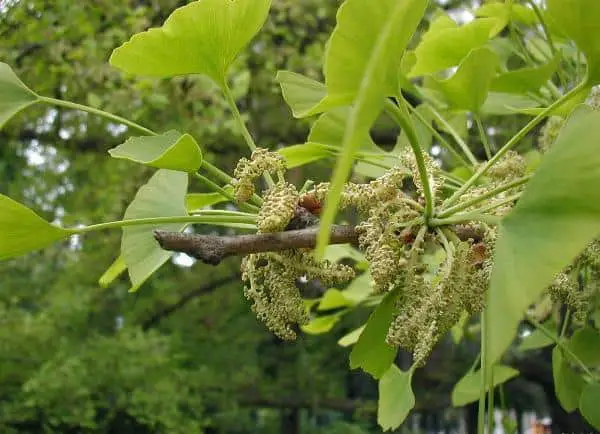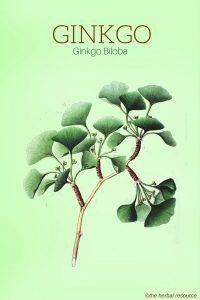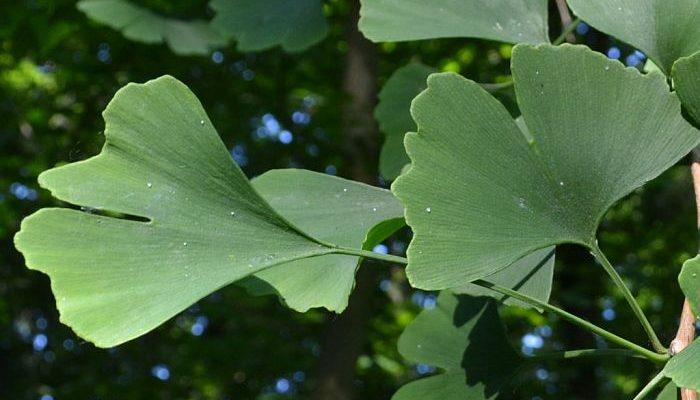Botanical Name: Ginkgo biloba.
Other Common Names: Ginkgo, duck’s foot tree, maidenhair, icho (Japanese), eunhaeng (Korean), arbre aux quarante écus (French), yinxing (Chinese), bai guo (seeds) and yin guo ye (leaves) (Chinese).
Habitat: Ginkgo biloba is found growing wild around Zhejiang in Eastern China and in the Tian Mu Shan Reserve. It is also cultivated in full sun and average soil in many moderate climate countries around the world.
Description: Ginkgo biloba has no close relative in the plant world. It is a tree with recognizable fossils dating as far back as 270 million years.
It is classified in its own division Ginkgophyta, class Ginkgoopsida, order Ginkgoales, family Ginkgoacae, genus Ginkgo and only the one species (G. biloba.)
The ginkgo is a deciduous tree with an average height of 20-35 meters tall. The tree has also been called maidenhair tree because of the resemblance between its leaves and the pinnae of the maidenhair fern.
It is a very long-living tree with some specimens over 2000 years old. The trees are deep-rooted and wind and snow resistant. It is also resistant to infection and pollution.
A testament to the hardiness of the Ginkgo tree can be seen in Hiroshima, Japan where four trees located within 2 kilometers of the atomic blast, though charred in the blast, are living and healthy to this day.
The ginkgo has separate male and female trees. The male tree produces small pollen cones that contain the sperm cells. The female tree produces a seed that is yellow-brown, soft and attractive but the coating smells similar to rancid butter when it falls to the ground.
Plant Parts Used: The leaves (extract supplement or dried leaf), fruit and seeds are used. Gingko biloba was first noted in medical use as early as 2800 B.C. by Emperor Shen Nung. Europeans were first introduced to the herb in the late 17th century.
The leaves are collected just before they change color in autumn and dried for use in distilled extracts, extracts, powders, tinctures and tablets. The seed kernels from mature fruits are boiled for use in decoction. The seeds can be eaten as snacks, or they can be dried or canned for use in soups and stews.

Therapeutic Uses, Benefits and Claims of Ginkgo Biloba
The leaves are very rich in flavonoids. Most importantly kaempferol glycoside, quercetin glycoside, the bitter ginkgolides A, B, C, J and M, and bilobalide.
The herb also contains tannins, phenols, bilobol and few potentially harmful substances like ginkgotoxin (4-O-methoxypyridoxine) and ginkgolic acids.
Ginkgo reduces the platelet activity factor (PAF) in the blood, similar to the action of aspirin on blood thinning. Excessive PAF has been linked to cardiovascular disease, brain damage, hearing disorders and other immune and inflammatory diseases.
Ginko biloba increases the body’s production of adenosine triphosphate (ATP), the main source of energy at the cellular level. ATP has been shown to enhance brain´s ability to convert glucose into energy and to increase the electrical activity.
The ginkgo flavonoids soften the thin capillaries, which has a positive effect on all the body’s organs, especially the brain.
Because of the herb’s potential antioxidant properties, it can be beneficial for the brain, retina and cardiovascular system which can lead to less damage by free radicals, age-related decline of brain function and naturally slowing down the aging process.
It may also increase metabolism, regulate neurotransmitters, and boost oxygen transport to the brain.
Many clinical trials have been conducted on the effectiveness of ginkgo biloba as a medicinal herb for treating Alzheimer’s disease and dementia. While some clinical trials have shown promising results other have found the herb ineffective.
It was originally used in ancient Chinese medicine as a treatment for asthma.
In Germany, gingko biloba has been regarded for some time to have potential in the treatment of Parkinson’s disease. Some studies have shown that the herb may reverse brain damage caused by exposure to toxic chemicals and that it has a long-acting positive effect on the metabolism of sugar and oxygen in the brain.
Numerous European studies indicate that ginkgo increases both short-term and long-term memory in people with age-related memory impairment or impairment in learning ability.
Clinical trials suggest that the herb could increase the activity of brain waves called alpha waves, and lessen the activity of theta waves.
These brainwave changes indicate that ginkgo might have the ability to enhance brain activity, resulting in increased mental acuity and improved concentration and memory which has led to the belief that the plant might have its uses as a medicinal herb for ADHD and ADD.
Ginkgo has been used to treat depression in the elderly in injunction with synthetic medicine and depression that could not be treated with conventional antidepressants and some trials have shown that ginkgo combined with ginger (Zingiber officinale) may reduce anxiety.
Some studies suggest that the flavonoids present in the plant could be helpful for people with age-related macular degeneration (ARMD), an eye disease that affects the retina. In addition, the use of ginkgo could slow the development of cataracts and protect against damage to the optic nerve in patients with glaucoma. More studies are needed.
The herb has been used as an herbal remedy for impotence. It contains substances that make blood vessels relax which could lead to greater blood flow to the penis and stronger erections.
An open clinical trial (without placebo) found that 76% of men who experienced sexual problems caused by the use of antidepressant drugs such as Prozac, Zoloft or Nardil regained sexual function after four to six weeks of taking ginkgo. The herb also caused increased desire and more powerful orgasms in women who experienced sexual problems after using antidepressants.
Gingko biloba might be helpful in preventing heart attack, stroke, and peripheral artery disease in cases where the underlying factor is atherosclerosis.
When a blood vessel is damaged, it will produce a fibrous tissue where cholesterol can accumulate and transform into plaque and cause the arteries to narrow. Ginkgo may slow down the formation of this tissue and relax constricted blood vessels.
Due to the herb’s ability to improve blood circulation, it has often been used to treat tinnitus or the feeling of a constant ringing or buzzing the ears or head.
Tinnitus is a very difficult ailment to treat and the use of ginkgo should under no circumstance replace a medical examination of tinnitus or hearing loss, as many conditions relating to such problems cannot be treated with herbs or supplements.
Ginkgo has also been used to fight the gradual loss of energy brought on by aging.
Dosage and Administration
The daily dose for most commercially made products of ginkgo bilboa is 120 to 240 mg or the manufacturer’s instructions should be followed.
Commercially made products should be standardized to contain no more than 24% flavonglycosides and 6% terpene lactones in a 50:1 extract.
Standardized products should contain no more than 5 parts per million (ppm) of the harmful ginkgolic acids.
Potential Side Effects of Ginkgo Biloba
Standardized ginkgo biloba where the harmful and allergenic substances have been removed is very safe to use when taken at the recommended dosages.
Individuals taking anticoagulant medication such as aspirin or warfarin should not use ginkgo biloba without consulting their physician.
Those on monoamine oxidase inhibitors (MAOI) or who might be pregnant should also consult their physician before use.
Side effects associated with ginkgo biloba use include: increased risk of bleeding, gastrointestinal discomfort, nausea, vomiting, diarrhea, headaches, dizziness, and restlessness. If any side effects are experienced use of ginkgo biloba should be discontinued.
Related Articles
The History of The Gingko Biloba Tree
Other Good Resources on Ginkgo Biloba
The Ginkgo Pages
A facinating website dedicated to the ginkgo biloba tree.
Supporting References
Ottariano, Steven G.: Medicinal Herbal Therapy. Portsmouth, Nicolin Fields Publishing 1999.
Ashton, A. K., Ahrens, K., Gupta, S., and Masand, P. S.: Antidepressant-induced sexual dysfunction and Ginkgo Biloba. Am J Psychiatry. 2000;157(5):836-837.
Mills, Simon & Kerry Bone: The Essential Guide to Herbal Safety. St. Louis, Elsevier 2005.
Bridi, R., Crossetti, F. P., Steffen, V. M., and Henriques, A. T.: The antioxidant activity of standardized extract of Ginkgo biloba (EGb 761) in rats. Phytother Res 2001;15(5):449-451.
Hobbs, Christopher: Ginkgo, Elixir of Youth. Santa Cruz, Botanica Press 1996.
Drew S, Davies E. Effectiveness of Ginkgo biloba in treating tinnitus: double-blind, placebo controlled trial. BMJ. 2001;322(7278):73.
Brown, Donald J.: Herbal Prescriptions for Health and Healing. Roseville, Prima Health 2000.
May BH, Lit M, Xue CC, Yang AW, Zhang AL, Owens MD, et al.: Herbal medicine for dementia: a systematic review. Phytother Res. 2008 Dec 11;23(4):447-459.
Braun, Lesley: Herbs & Natural supplements. An evidence-based guide. 3nd edn. Chatswood, NSW 2067, Elsevier Australia 2010.
Nathan, P. J., Harrison, B. J., and Bartholomeusz, C.: Ginkgo and memory. JAMA. 2-5-2003;289(5):546-548.
Balch, Phyllis A.: Prescription for Herbal Healing. New York, Avery 2002.
Basch, Ethan M.: Natural Standard Herb & Supplement Handbook. The Clinical Bottom Line. St. Louis, Missouri. Elsevier Mosby 2005.
Thordur Sturluson
Latest posts by Thordur Sturluson (see all)
- What is the Difference Between Hemp and Marijuana? - June 3, 2019


Hello Sir/Ma,
What is the name of Gingko in Igbo Language?